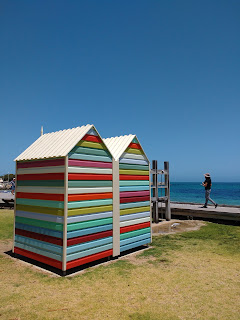After three months travelling through rural and remote areas, being in the big city was quite an adjustment. Navigating busy motorways, rush hour and SO MANY PEOPLE was almost a culture shock!
Our time in Perth doubled as an opportunity to catch up with family who were visiting. We based ourselves in a caravan park in the northern suburbs of Perth, within 20 minutes drive of the CBD. As a bonus, the children were able to take full advantage of the playground, jumping pillow, two swimming pools and spa pool.
On our first day, Nana and Grandad took the two older children to the zoo (via bus and ferry - very exciting!) while Mats, Stella and I drove 45 mins south to the next town, Fremantle.
It was love at first sight! The architecture is stunning, with some of the buildings along the waterfront built by convicts in the early 1800’s (ancient by Australian standards!) I hadn't realised how much I missed the sense of historical context and the old architecture until I was there. At 101 years old, Canberra is sorely lacking in this area.
We first visited the Roundhouse, a convict built former jail, complete with gorgeous views of the Indian Ocean and a tunnel underneath which was used as a means of quickly unloading whaling boats, and later as an air raid shelter in WWII.
We followed the waterfront along to the harbour, where we marvelled at the immense size of the container ships.
No trip to Fremantle would be complete without a visit to the famous Little Creatures Brewery, so of course we had to check it out for ourselves. Great beer did not disappoint, but the big surprise was the fabulous made-to-order pizza. My pesto, roast pumpkin and pinenut may have been the best pizza I've ever had!
Our second day saw us returning to Fremantle with the entire family, this time by train. The public transport system in Perth is fantastic. Free buses cover most of the city every 10 minutes or so, running on three colour coded routes. The train was just as easy to navigate, although not free.
Our destination was the Maritime museum, at the request of Luka, in celebration of his 8th birthday. Mats, Grandad, Luka and Freya enjoyed an hour long tour of an Oberon class submarine, the HMAS Ovens, while Nana, Stella and I explored the exhibits.
From there we headed to the Shipwreck Museum (also a birthday request) to see treasures salvaged from some of the many shipwrecks along the Western Australian coast. Luka's favourites were silver coins from the 1400’s (real pirate treasure!), part of the hull of the Batavia and a skeleton (real bones, not a replica) of one of the crew members from the Batavia.
Our experience was made even more special by the lovely curator who was so delighted to hear that Luka's birthday request was a visit to the Shipwreck Museum that she gave him a personal tour, highlighting objects of most interest to an 8 year old. She also presented both Luka and Freya with a souvenir coin.
The next day we rode the free bus right across Perth, from the east side to the west, where we explored a little of the massive Kings Park. Our first stop was one of the many playgrounds (of course!) where we enjoyed a picnic lunch before wandering around to the botanic gardens and the war memorial, which has great views of the Swan River and city centre.
The next stop was the Rio Tinto nature based play space - a fantastic play area which tries to recreate the type of play children can have in a natural environment. The creek was great for paddling on a warm day, and the “fallen” log bridges much more fun than a regular bridge. There were caves and tunnels to be explored, a very high treehouse and materials for building a bivouac/cubby/fort.
We probably saw less than a quarter of Kings Park, but were very impressed. What a wonderful asset in a city environment.
We barely scratched the surface of all the great places to see and things to do in Perth due to limitations of time, but were very impressed by its liveability, with fantastic green space and enviable public transport system.












































